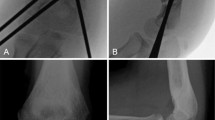Abstract
Purpose
To analyse the clinical outcomes of 26 children treated surgically for displaced proximal humerus fracture.
Materials and methods
From January 2008 to December 2012, 26 children/adolescents (14 boys, 12 girls) were treated surgically for displaced fractures at the proximal extremity of the humerus. Ten were grade III and 16 were grade IV according to the Neer–Horowitz classification with a mean age of 12.8 ± 4.2 years. Twenty young patients were surgically treated with a closed reduction and direct percutaneous pinning; six required an open approach. To obtain a proper analysis, we compared the Costant scores with the contralateral shoulder (Δ Costant).
Results
The mean follow-up period was 34 months (range 10–55). Two grade IV patients showed a loss in the reduction after percutaneous treatment. This required open surgery with a plate and screws. On average, the treated fractures healed at 40 days. The mean Δ Costant score was 8.43 (range 2–22). There was a statistically significant improvement in the mean Δ Costant score in grade III patients. In grade IV patients, there was a significant improvement in the mean Δ Costant score in those treated with open surgery versus mini-invasive surgery.
Conclusions
Our study shows excellent results with percutaneous k-wires. This closed surgery had success in these patients, and the excellent outcomes noted here lead us to prefer the mini-invasive surgical approach in NH grade III fractures. In grade IV, the best results were noted in patients treated with open surgery. We suggest an open approach for these patients.
Level of evidence
III.

Similar content being viewed by others
References
Rose SH, Melton LJ 3rd, Morrey BF et al (1982) Epidemiologic features of humeral fractures. Clin Orthop Relat Res 168:24–30
Shrader MW (2007) Proximal humerus and humeral shaft fractures in children. Hand Clin 23:431–435
Fernandez FF, Eberhardt O, Langendörfer M et al (2008) Treatment of severely displaced proximal humeral fractures in children with retrograde elastic stable intramedullary nailing. Injury 39:1453–1459
Pandya NK, Behends D, Hosalkar HS (2012) Open reduction of proximal humeral fractures in the adolescent population. J Child Orthop 6:111–118
Binder H, Schurz M, Aldrian S et al (2011) Physeal injuries of the proximal humerus: long-term results in seventy two patients. Int Orthop 35(10):1497–1502
Dodwell ER, Kelley SP (2011) Physeal fractures: basic science, assessment and acute management. Orthop Trauma 25:5
Di Gennaro GL, Spina M, Lampasi M (2008) Fractures of the proximal humerus in children. Chir Organi Mov 92:89–95
Constant CR, Murley AG (1987) A clinical method of functional assessment of the shoulder. Clin Orthop Relat Res 214:160–164
Beaton DE, Wright JG, Katz JN (2005) Development of the Quick-DASH: comparison of three item-reduction approaches. J Bone Joint Surg Am 87:1038–1046
Bahrs C, Zipplies S, Ochs BG et al (2009) Proximal humeral fractures in children and adolescents. J Pediatr Orthop 29(3):238–242
Pahlavan S, Baldwin KD, Pandya NK et al (2011) Proximal humerus fractures in the pediatric population: a systematic review. J Child Orthop 5:187–194
Robinson TW, Corlette J, Collins CL et al (2014) Shoulder injuries among US high school athletes, 2005/2006–2011/2012. Pediatrics 133(2):272–279
Hutchinson PH, Bae DS, Waters PM (2011) Intramedullary nailing versus percutaneous pin fixation of pediatric proximal humerus fractures: a comparison of complications and early radiographic results. J Pediatr Orthop 31(6):617–622
Mehin R, Mehin A, Wickham D et al (2009) Pinning technique for shoulder fractures in adolescents: computer modelling of percutaneous pinning of proximal humeral fractures. Can J Surg 52:E222–E228
Dobbs MB, Luhmann SL, Gordon JE et al (2003) Severely displaced proximal humeral epiphyseal fractures. J Pediatr Orthop 23:208–215
Lefèvre Y, Journeau P, Angelliaume A (2014) Proximal humerus fractures in children and adolescents. Orthop Traumatol Surg Res 100(1 Suppl):S149–S156
Kim SH, Szabo RM, Marder RA (2012) Epidemiology of humerus fractures in the United States: nationwide emergency department sample. Arthritis Care Res 64:407–414
Burgos-Flores J, Gonzalez-Herranz P, Lopez-Mondejar JA et al (1993) Fractures of the proximal humeral epiphysis. Int Orthop 17:16–19
Wei SW, Zhao YM, Yang J et al (2012) Manipulative reduction and percutaneous pin fixation for the treatment of severely displaced proximal humerus fractures in children. Zhongguo Gu Shang 25:158–161
Funding information
This study was funded by the authors.
Author information
Authors and Affiliations
Corresponding author
Ethics declarations
Conflict of interest
Each author certifies that he/she has no commercial associations that might pose a conflict of interest in connection with the submitted article.
Ethical approval
All procedures performed in studies involving human participants were in accordance with the ethical standards of the institutional and/or national research committee and with the 1964 Helsinki Declaration and its later amendments or comparable ethical standards. Informed consent was obtained from all individual participants included in the study.
Rights and permissions
About this article
Cite this article
Pavone, V., de Cristo, C., Cannavò, L. et al. Midterm results of surgical treatment of displaced proximal humeral fractures in children. Eur J Orthop Surg Traumatol 26, 461–467 (2016). https://doi.org/10.1007/s00590-016-1773-z
Received:
Accepted:
Published:
Issue Date:
DOI: https://doi.org/10.1007/s00590-016-1773-z




